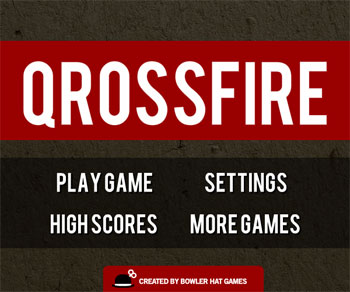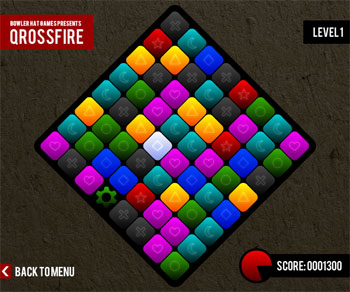Two weeks ago, my company Bowler Hat Games released a new game called Qrossfire. Within a short time, Mochi Media featured Qrossfire as a Flash Game Friday winner. Today, the game reached a milestone of one million plays. I attribute Qrossfire’s success to a few factors, including a focus on graphics, better playtesting, and building upon an already successful and familiar gameplay mechanics.
With Qrossfire, I spent some extra time creating unique art and graphics. Color, in particular, played a big role in giving Qrossfire the personality it needed and the quality of gameplay I wanted. I tried to pick strong primary colors with heavy saturation, in a balanced set of brightness levels. With both Chroma Circuit and Gridshock, a small number of players complained that some of the colors weren’t different enough, and it made the game a bit harder to play. To compensate in Chroma Circuit, I added a color-blind mode with very high-contrast colors. For Qrossfire, I tried to ensure from the start that the colors I chose would work well together aesthetically and technically. As a fallback, I also added unique shapes to go along with each of the colors.
Qrossfire was the first game of mine to use the First Impressions feature on FlashGameLicense. It’s a wonderful option that puts your game in front of a variety of players with many backgrounds and skill levels, and you receive their honest feedback, as if the game were out in the real world. While I’ve heard that many developers put early versions of their games up there, I decided to upload Qrossfire later in development when I was mostly adding finishing touches. Regardless, the participants gave me excellent advice related to sound effects, difficulty, and controls. Between the comments from these helpful souls and very useful suggestions I received some of the potential licensees on FGL, I was able to make Qrossfire more dynamic, interesting, and universally enjoyable. If you sell licenses for your games on FGL, I highly recommend this feature, and I don’t doubt that I will use it again.
From the beginning, I intended to create Qrossfire using an established formula. While I strive to create unique games that stand out from the crowd and go in their own differing directions, even when we’re talking simple puzzle games, there are benefits to me as a game developer to building an old standard that’s tried and true.
-
More experience. This is only my third game, and a good way to spend more time on graphics, sound, and other non-development areas is to create something that won’t require too much thought from the engineering side of my brain. This choice also lets me spend a bit more time refining the project structure and architecture. What I learn from those possible improvements, I can take with me to my next game and beyond.
-
Creative exercise. What better way to force myself to be creative than to take an established—and nearly overdone—genre and try to find a fresh way to present it to players? A good balance between new and familiar elements is often the best way to find success.
-
It’s relaxing. I have plans in the works for an epic sequel to Chroma Circuit with more levels, new game modes, and some very exciting new features—all of which offer me great revenue potential. I’ve also been experimenting and brainstorming for games in genres I haven’t tried yet. Giving my mind a short break from planning those longer-term tasks allows me to restart them later with a fresh perspective and new ideas.
Currently, I’m taking a short break from game development to do some Flex consulting work. I hope that games will be able to pay the bills sooner than later, but I’m still not there yet. Thankfully, I only need to work for about three months to allow myself to work fulltime on games well into 2010. Hopefully, I’ll get started on a new game in early October. In the meantime, I’ll be doing customizations for portals that want site-locked licenses of my existing games, exploring interesting technologies I may be able to use in my games in the future, and enjoying the summer as much as possible.


wow congrats for the success of your games!
Pingback: Bowler Hat Games Phase Two Begins: Chroma Circuit for iPhone « Josh Talks Flash